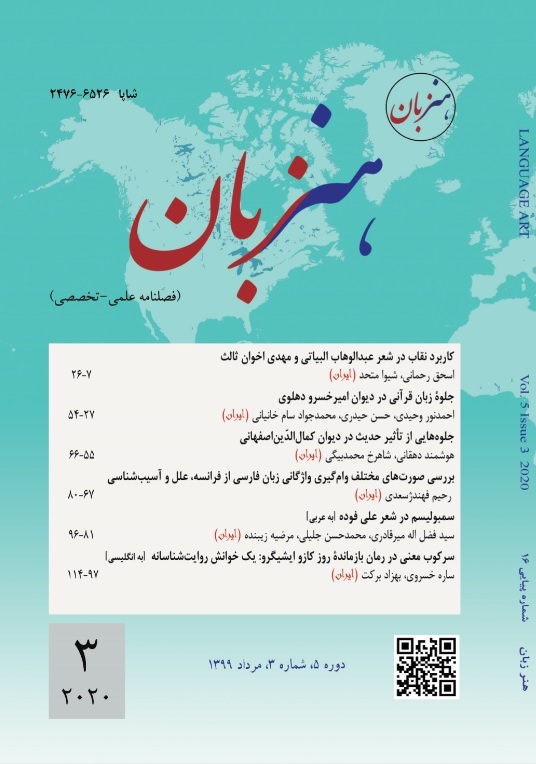The Suppression of meaning in Kazuo Ishiguro's The Remains of the Day
DOI:
https://doi.org/10.22046/LA.2020.18الكلمات المفتاحية:
Suppression of Meaning, The Remains of the Day, Unreliable Narrator, Figurative Language, Metaphor, Metonymy.الملخص
This article focuses on Kazuo Ishiguro’s The Remains of the Day and the way the language of the novel suppresses meaning. After illuminating the concept of meaning suppression and its formation, the study offers two strategies with which meaning suppression is manifested: the unreliability of the narrator and the employment of the figurative language. The influential Factors in the unreliability of the narrator which contribute to meaning suppression are: first-person narrator, memory telling, discursive habits of the narrator and the contradiction between scenic presentations and commentaries. The other strategy contributing to the suppression of meaning in the novel is the figurative language. The figurative devices in this novel deviate the meaning from its conventional process of understanding and pave the way for the formation of meaning suppression. The devices to be discussed in this article are metaphor, metonymy, irony and euphemism each of which play their roles in fulfilling the goal of the study. The study, by bringing evidence from the text, highlights their contribution to the goal of the research. What the study proposes as a result is the way meaning suppression or more specifically, the unreliability of the narrator and the figurative language, deviate the meaning from the normal process of meaning formation.المراجع
Abrams, M.H. (1999). A Glossary of Literary Terms. U.S: Heinle & Heinle.
Bal, Mieke (2007). Narrative Theory: Critical Concepts in Literary and Cultural Studies. Ed: id. London/New York: Routledge.
Billig, Michael (2004). Freudian Repression: Conversation Creating the Unconscious. Cambridge: Cambridge University Press.
Bloom, Harold (2004). The Best Poetry of the English Language: From Chaucer through Frost. New York: Hypercollins.
Booth Wayne, C. (2004). “Types of Narration” in: Narrative Theory: Critical Concepts in Literary and Cultural Studies. Mieke Bal (ed). London/New York: Routledge. 138-146.
Ellestrom, L., & Elleström, L. (2002). Divine madness: On interpreting literature, music, and the visual arts ironically. Bucknell University Press.
Fowler, F.G. Henry Watson Fowler. (1906). The King’s English. Oxford: Oxford University Press
Gernsbacher, Morton Ann and Rachel R.W. Robertson (1999). “ the Role of Suppression in Figurative Language Comprehension”. J Pragmat. Nov 2. 31(12), pp.1619–1630.
Green, Marc (2013). “Eyewitness Memory is Unreliable”. www.visualexpert.com/Resources/eyewitnessmemory.html (Last retrieved 2016. 5. 27)
Grigg, Russell (2009). Lacan, language, and philosophy, chapter 11 Lacan and Jakobson - Metaphor and Metonymy pp. 151–2, 160
Ishiguro, Kazuo, (1993). The Remains of the Day. New York: Vintage Books.
Jakobson, Roman and Morris Halle. (2002). Fundamentals of Language. Berlin/New York: Mouton de Gruyter.
Littlemore, Jeannette. (2015). Metonymy: Hidden Shortcuts in Language, Thought and Communication. Cambridge: Cambridge University press.
Niederhoft, Burkhard. (2011). “Unlived lives in Kazuo Ishiguro’s The Remains of the Day and Tom Stoppard’s The Invention of Love. Connotations. 20 (2-3) (2010/2011)pp. 164-188.
Nunning, Ansgar. (2005). “Reconceptualizing Unreliable Narration: Synthesithing Cognitive and Rhetorical Approaches”. In: James Phelan and Peter J Rabinowitz (eds). A Companion to Narrative Theory. Oxford: Blackwell.
Prince, Gerald. (2007). “The disnarrated. In: Mieke Bal (ed.). Narrative Theory: Critical Concept in Literary and Cultural Studies. London/ New York: Routledge. 297-305.
Rema. N. (2015). “The Unreliable Narration and the Suppression of Emotions in Kazuo Ishiguro’s the Remains of the Day”. International Journal of Scientific and Research Publications. 5(7), pp. 1-3.
Riffaterre, M. (1983). Text Production, New York: Columbia University Press.
Riggan, W. (1981). Picaros, Madmen, Naifs, and Clowns: The Unreliable First-Person Narrator. Norman: University of Oklahoma Press.
Rimmon-Kenan, S. ([1983] 2005). Narrative Fiction: Contemporary Poetics. London/ New York: Routledge.
Shaffer, Brian. W. (1998). Understanding Kazuo Ishiguro. California: University of California Press.
Vorda, Allan and Kim Herzinger.(2008). “An Interview with Kazuo Ishiguro”. In: Brian, W, Shaffer and Cynthia, F, Wong (eds). Conversations with Kazuo Ishiguro. Mississippi: University Press of Mississippi. 48[…]66-88.
Warhol, Robyn. (2005). “Neonarrative; or, How to Render the Unnarratable in Realist Fiction and Contemporary Film” in: James Phelan and Peter J. Rabinowits. A Companion to Narrative Theory. London: Blackwell Publishing Ltd. 220- 231.
التنزيلات
منشور
كيفية الاقتباس
إصدار
القسم
الرخصة
الحقوق الفكرية (c) 2022 Sareh Khosravi, Behzad Barekat

هذا العمل مرخص بموجب Creative Commons Attribution 4.0 International License.

